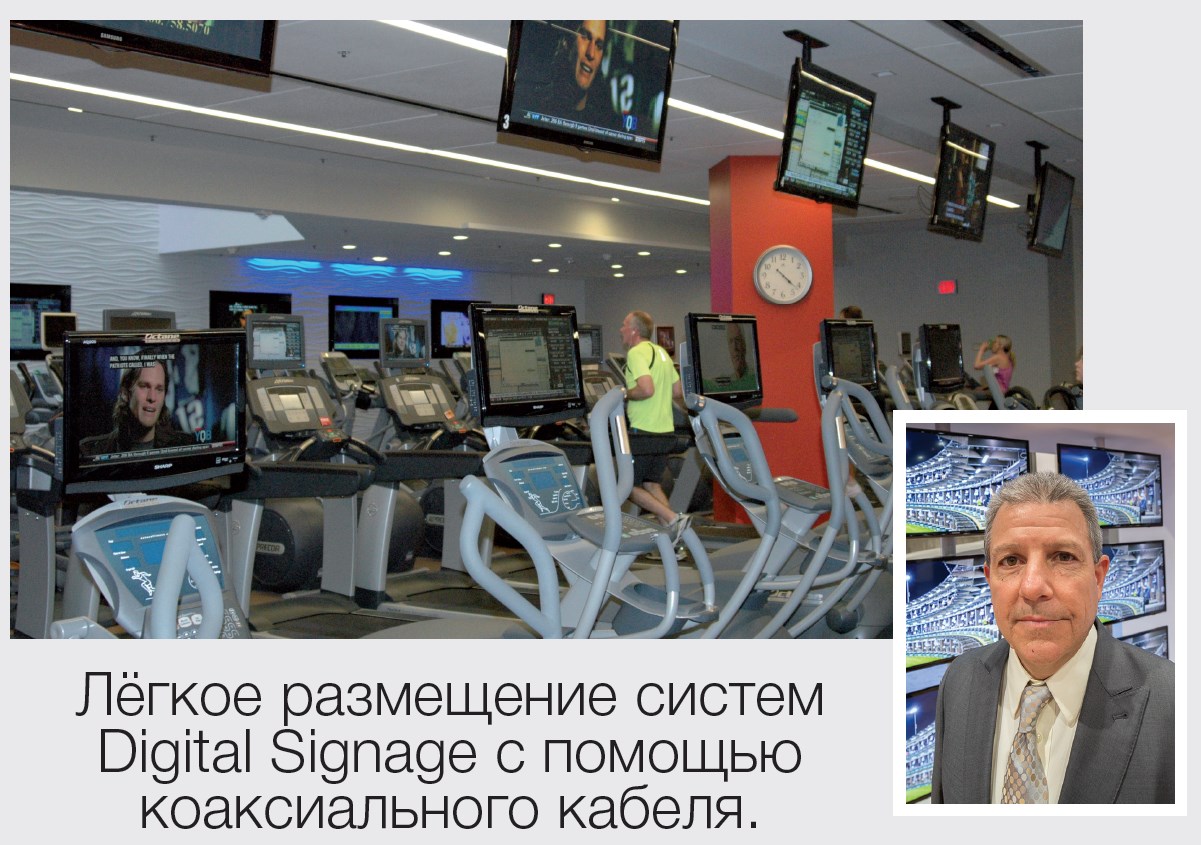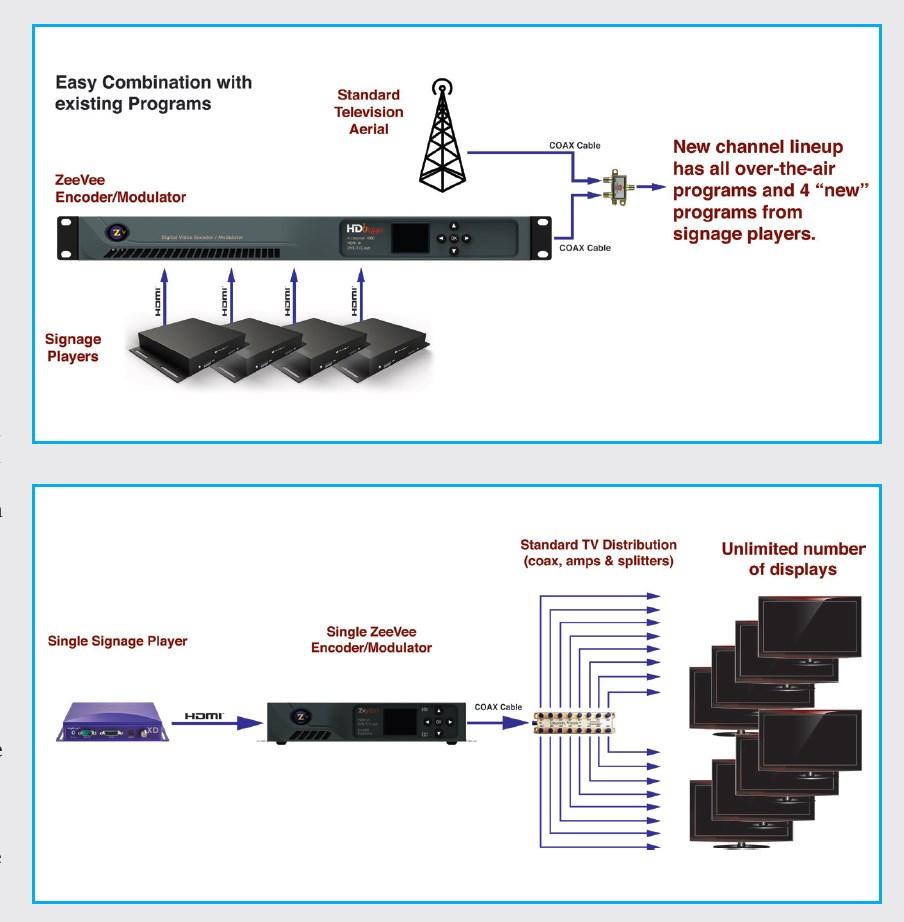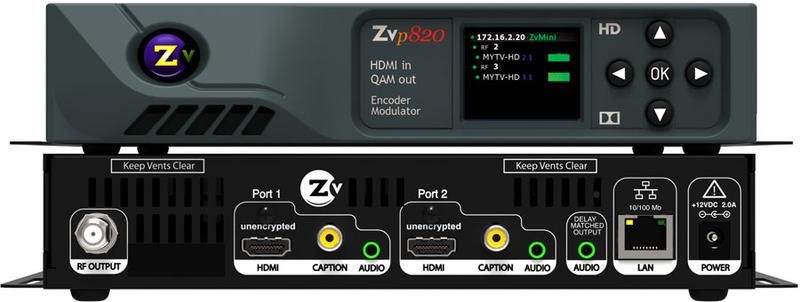ZeeVee Encoders / Modulators
- Transfer
Technology is evolving, and at the same time, all things are becoming more complex. And suddenly something very simple, really new and useful, appears. This is how the ZeeVee solution for transmitting HD signal over coaxial cable can be described.

And here you can meet a surprised reaction: on a coaxial cable? COAXIAL? ZeeVee relies on technology that is difficult to criticize. Their series of signal transmitting devices for AV, TV and digitalsignage systems makes it obvious that using existing technology will in most cases be an easy and effective solution with better payback.
On the one hand, the surprise is understandable. On the other hand, ZeeVee is the No. 1 provider of coaxial solutions in the United States and is the only certified provider of DirectTV and Dish, the American equivalents of Sky, Bt and Virgin. And this is a good argument in favor of the company.
Initially, ZeeVee has two series of solutions for transmitting HD signals: the ZvPro series, for use with small systems (one or two channels) and HDBridge - for use with a large number of channels.
The company has developed, providing solutions for the transmission of TV signals and with the advent of new technologies, has been engaged in developing digital signage systems. With a coaxial cable bandwidth of more than 5 GB, the company's solutions ideally suited the requirements of digitalsignage HD systems. With devices for signal transmission and the presence of coaxial cable in most buildings, the company quickly gained momentum, and with them growth and recognition. Now ZeeVee has arrived in Europe, and in October last year an office was opened in the UK. But before these, the company spent 12 months to make sure that their devices work perfectly with all European standards. All ZeeVee developments are based on their own chip, which provides many options for solving a wide range of tasks.
It is worth mentioning that the company is a partner of NEC and the company's solutions showed excellent results at the NECShowcase exhibition in May this year. The devices were used to transmit signals from Scala's broadcast cameras and media players to screens and video walls around the showroom.
The benefits of using coaxial cable.
So why all the same coaxial cable? ZeeVee devices model the signal through an existing or new network consisting of coaxial cables. And according to company statements, such a solution has great benefits compared to alternative signal transmission solutions.
A coaxial cable can already be placed in the building and in this case it becomes possible, using just one player and encoder / modulator, to transmit a signal to an infinite number of TV screens and / or displays at an infinite distance.

The solutions are integrated quite easily, since the modulators are located in the immediate vicinity of the signal source and all content is transmitted through one coaxial cable. There is no need for direct cabling, transmitters, switches and receivers. The cable structure includes chamomile and star twisting or any combination to ensure signal transmission over distances far exceeding 100 meters, which is a limitation when transmitting over IP. It is important to pay attention to the fact that the coaxial cable can be connected directly to the TV, and this, in turn, eliminates the known risks inherent in the CatX standard. Thus, the signal transmission via coaxial cable, according to the company, has virtually no boundaries in distance.
The coaxial network also allows you to hold the player, and in this case only one player, at your workplace, or in any other place where there is a coaxial connection for quick access and easy control, not forgetting about its safety. And there is no longer any need to keep a “box” behind each of the screens, all that is needed is a direct connection from the player to the modulator and then to the screen.
This technology has long proven its convenience and versatility. With a bandwidth far superior to Cat5 / 6, it has been the mainstay of cable and satellite companies for many years. Moreover, additional channels and / or screens can be easily added without disrupting work, creating unnecessary infrastructures and the cost of equipment and labor. Just imagine, hotels, stadiums, bars and restaurants can easily add an information or advertising channel to an existing network and hundreds and thousands of visitors will immediately see this information.
ZeeVee's solution is high frequency. If you need to send 100 unique messages simultaneously to 100 screens, you must use 25 (x4 channels) devices in one place. Coaxial cable connects directly to the TV and does not require additional equipment. A true example of simplicity!
A high-frequency modulator from ZeeVee makes any AV source a TV channel, the signal from which is subsequently transmitted. The screen may be a regular consumer TV with a built-in digital tuner. For displays and projectors without an integrated tuner, ZeeVee offers the use of an external ZvSync tuner.
On the screen tuned to the channel, the signal from the source will be reproduced through the modulator. Thus, all that a modulator needs to transmit a signal from a source is an idle channel.
Attracting surprised looks.
Digital signage is always the brightness and attractiveness in presenting a brand, product or opportunity. And all that is needed to arouse the interest of visitors is a crystal clear HD image. ZeeVee’s solution has every opportunity to present your message in the best possible way. The company's devices can rightly boast excellent image quality. In addition to easy setup, the devices are compatible with both analog and digital sources, supporting standard and HD resolutions.

ZeeVee devices can also find other useful applications, such as emergency alerts. When, in certain situations, for example, during a fire, a message about evacuation from the building is transmitted through all the channels of the network.
Advantages of the new player.
Although there is a tendency to mount media players on the back of the displays, ZeeVee finds this solution uncomfortable and expensive. There is no need for content used on multiple screens to be stored in several places at once. Expanding the system is too costly, as adding a display means adding both a player and cables. Do not forget about the restrictions on the distance of 100 meters for IP solutions and the addition of a power source for the player.
For example, for the purpose of informing employees, the company decided to create a digital signage system consisting of 20 screens. The main tasks are: the ability to effectively alert, low costs and easy maintenance. And another important detail is the future possibility of expanding this system.
When using a solution with a player for each display, sending a unique message to your display is quite feasible. But when several displays display a single message, this means that there is no need for a separate player for each screen. Be that as it may, in such a system a player should be for each display and, as a result, busting with equipment, which entails great costs.
In the case of using the solution from ZeeVee, transmission via coaxial cable is possible from the players to any number of screens and at any distance. Since the information of each player will be transmitted to a specific HDTV channel, screens tuned to this channel will automatically display the signal from the player.
In conclusion, we can say that digital signage systems created using the ZeeVee coaxial solution are the most economical and efficient. This is a platform that allows you to transmit HD-signal from more than 100 channels to an infinite number of displays and any distance using a convenient cable network. Installation in a new or existing coaxial network is absolutely simple and there is always the opportunity to further expand the network by adding channels and displays.

And here you can meet a surprised reaction: on a coaxial cable? COAXIAL? ZeeVee relies on technology that is difficult to criticize. Their series of signal transmitting devices for AV, TV and digitalsignage systems makes it obvious that using existing technology will in most cases be an easy and effective solution with better payback.
On the one hand, the surprise is understandable. On the other hand, ZeeVee is the No. 1 provider of coaxial solutions in the United States and is the only certified provider of DirectTV and Dish, the American equivalents of Sky, Bt and Virgin. And this is a good argument in favor of the company.
Initially, ZeeVee has two series of solutions for transmitting HD signals: the ZvPro series, for use with small systems (one or two channels) and HDBridge - for use with a large number of channels.
The company has developed, providing solutions for the transmission of TV signals and with the advent of new technologies, has been engaged in developing digital signage systems. With a coaxial cable bandwidth of more than 5 GB, the company's solutions ideally suited the requirements of digitalsignage HD systems. With devices for signal transmission and the presence of coaxial cable in most buildings, the company quickly gained momentum, and with them growth and recognition. Now ZeeVee has arrived in Europe, and in October last year an office was opened in the UK. But before these, the company spent 12 months to make sure that their devices work perfectly with all European standards. All ZeeVee developments are based on their own chip, which provides many options for solving a wide range of tasks.
It is worth mentioning that the company is a partner of NEC and the company's solutions showed excellent results at the NECShowcase exhibition in May this year. The devices were used to transmit signals from Scala's broadcast cameras and media players to screens and video walls around the showroom.
The benefits of using coaxial cable.
So why all the same coaxial cable? ZeeVee devices model the signal through an existing or new network consisting of coaxial cables. And according to company statements, such a solution has great benefits compared to alternative signal transmission solutions.
A coaxial cable can already be placed in the building and in this case it becomes possible, using just one player and encoder / modulator, to transmit a signal to an infinite number of TV screens and / or displays at an infinite distance.

The solutions are integrated quite easily, since the modulators are located in the immediate vicinity of the signal source and all content is transmitted through one coaxial cable. There is no need for direct cabling, transmitters, switches and receivers. The cable structure includes chamomile and star twisting or any combination to ensure signal transmission over distances far exceeding 100 meters, which is a limitation when transmitting over IP. It is important to pay attention to the fact that the coaxial cable can be connected directly to the TV, and this, in turn, eliminates the known risks inherent in the CatX standard. Thus, the signal transmission via coaxial cable, according to the company, has virtually no boundaries in distance.
The coaxial network also allows you to hold the player, and in this case only one player, at your workplace, or in any other place where there is a coaxial connection for quick access and easy control, not forgetting about its safety. And there is no longer any need to keep a “box” behind each of the screens, all that is needed is a direct connection from the player to the modulator and then to the screen.
This technology has long proven its convenience and versatility. With a bandwidth far superior to Cat5 / 6, it has been the mainstay of cable and satellite companies for many years. Moreover, additional channels and / or screens can be easily added without disrupting work, creating unnecessary infrastructures and the cost of equipment and labor. Just imagine, hotels, stadiums, bars and restaurants can easily add an information or advertising channel to an existing network and hundreds and thousands of visitors will immediately see this information.
ZeeVee's solution is high frequency. If you need to send 100 unique messages simultaneously to 100 screens, you must use 25 (x4 channels) devices in one place. Coaxial cable connects directly to the TV and does not require additional equipment. A true example of simplicity!
A high-frequency modulator from ZeeVee makes any AV source a TV channel, the signal from which is subsequently transmitted. The screen may be a regular consumer TV with a built-in digital tuner. For displays and projectors without an integrated tuner, ZeeVee offers the use of an external ZvSync tuner.
On the screen tuned to the channel, the signal from the source will be reproduced through the modulator. Thus, all that a modulator needs to transmit a signal from a source is an idle channel.
Attracting surprised looks.
Digital signage is always the brightness and attractiveness in presenting a brand, product or opportunity. And all that is needed to arouse the interest of visitors is a crystal clear HD image. ZeeVee’s solution has every opportunity to present your message in the best possible way. The company's devices can rightly boast excellent image quality. In addition to easy setup, the devices are compatible with both analog and digital sources, supporting standard and HD resolutions.

ZeeVee devices can also find other useful applications, such as emergency alerts. When, in certain situations, for example, during a fire, a message about evacuation from the building is transmitted through all the channels of the network.
Advantages of the new player.
Although there is a tendency to mount media players on the back of the displays, ZeeVee finds this solution uncomfortable and expensive. There is no need for content used on multiple screens to be stored in several places at once. Expanding the system is too costly, as adding a display means adding both a player and cables. Do not forget about the restrictions on the distance of 100 meters for IP solutions and the addition of a power source for the player.
For example, for the purpose of informing employees, the company decided to create a digital signage system consisting of 20 screens. The main tasks are: the ability to effectively alert, low costs and easy maintenance. And another important detail is the future possibility of expanding this system.
When using a solution with a player for each display, sending a unique message to your display is quite feasible. But when several displays display a single message, this means that there is no need for a separate player for each screen. Be that as it may, in such a system a player should be for each display and, as a result, busting with equipment, which entails great costs.
In the case of using the solution from ZeeVee, transmission via coaxial cable is possible from the players to any number of screens and at any distance. Since the information of each player will be transmitted to a specific HDTV channel, screens tuned to this channel will automatically display the signal from the player.
In conclusion, we can say that digital signage systems created using the ZeeVee coaxial solution are the most economical and efficient. This is a platform that allows you to transmit HD-signal from more than 100 channels to an infinite number of displays and any distance using a convenient cable network. Installation in a new or existing coaxial network is absolutely simple and there is always the opportunity to further expand the network by adding channels and displays.
